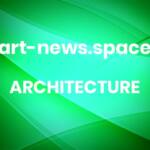In the 1940s, Frank Lloyd Wright conjured a vision for Pittsburgh.
The architect imagined a striking residential block towering above the city’s downtown Golden Triangle, where the Allegheny and Monongahela rivers converge. To tackle the area’s chronic parking shortage, he dreamed up a spiral-shaped self-service garage. Boldest of all, he conceived a sprawling civic center, its futuristic, circular terraces encompassing arts venues, a sports arena, a planetarium, and open-air spaces. Ambitious and visionary, these designs, alas, were never realized.
Frank Lloyd Wright, bird’s-eye view from Mount Washington, Civic Center at Point Park for the Allegheny Conference (1947). Photo: The Frank Lloyd Wright Foundation Archives, The Museum of Modern Art | Avery Architectural & Fine Arts Library, Columbia University, New York.
But they now anchor “Frank Lloyd Wright’s Southwestern Pennsylvania: The Pittsburgh Projects,” an exhibition on view at the city’s 820 Gallery, featuring the architect’s original drawings alongside digital renderings. The show originated in 2023 at the Westmoreland Museum of American Art in Greensburg, Pennsylvania and traveled to Washington, D.C.’s National Building Museum; its Pittsburgh stop, presented by the Pittsburgh Cultural Trust, brings Wright’s forward-looking proposals back to the place that inspired them.
“These unrealized projects feel especially resonant today, as Pittsburgh once again embraces bold ideas in urban design,” Anastasia James, director of galleries and public art at the Pittsburgh Cultural Trust, said in a statement. She highlighted the forthcoming Arts Landing, an outdoor civic space set to feature rotating artist installations, opening not far from where Wright pictured his potential Pittsburgh.
“What a great way to talk about the future,” Scott Perkins, curator and senior director of Fallingwater, told me over a video call, “and also talk about the past.”
Project for Civic Center at Point Park for the Allegheny Conference, digital illustration (2023) by Skyline Ink Animators + Illustrators, designers. Based on an unrealized design by Frank Lloyd Wright (1947) and created by permission of the Frank Lloyd Wright Foundation, all rights reserved.
What Frank Lloyd Wright Planned for Pittsburgh
Wright’s designs for Pittsburgh were commissioned by department store mogul Edgar J. Kaufmann between the 1930s and ’50s. A civic-minded patron of the arts, Kaufmann sought to revitalize the industrial city with culture and architecture. He hosted exhibitions at his massive flagship store and recruited artists to create murals for its interior, while playing a key role in the Allegheny Conference on Community Development (ACCD). Perkins called him a “tastemaker,” who was “very progressive in bringing art, fashion, and design to Pittsburgh.”
Frank Lloyd Wright. Photo: Bettmann Archive, Getty Images.
One of the creatives Kaufmann seized on was Wright, who he commissioned to design his store’s executive offices and, most famously, Fallingwater, the residence that transformed Wright’s fortunes. Kaufmann continued to enlist the architect in his plans to revitalize downtown Pittsburgh through the ACCD. Among these efforts was his 1940s presentation “Pittsburgh in Progress,” which aimed to address the city’s congestion and pollution with schemes for efficient land use and sustainable design.
“This exhibit,” read its accompanying booklet, “has been prepared on the premise that there will be an expansion in the civilized use of intellect, heart, science, and technology and that the atomic age will be an era of construction.”
Frank Lloyd Wright, view from the northwest, Point View Residences for the Edgar J. Kaufmann Charitable Trust (Scheme II) (11 April 1953). Photo: The Frank Lloyd Wright Foundation Archives, The Museum of Modern Art | Avery Architectural & Fine Arts Library, Columbia University, New York.
In that spirit emerged Wright’s proposals, though they ultimately went unbuilt. His design for the civic center was envisioned for the ACCD—”it allowed him essentially a blank canvas of the Triangle in Pittsburgh,” per Perkins—but was later rejected for unknown reasons. The innovative parking garage, meant to adjoin the Kaufmann’s department store, went similarly unrealized.
Meanwhile, the Point View Residences project, a triangular structure perched on the side of Mt. Washington, was designed for the Edgar J. Kaufmann Charitable Fund. But it was abandoned by Kaufmann in 1953 after his associates warned him of its financial risk (facets of the apartment building’s design can be glimpsed in Wright’s Oklahoma skyscraper, Price Tower).
Project for Point View Residences for the Edgar J. Kaufmann Charitable Trust, digital illustration (2023) by Skyline Ink Animators + Illustrators, designers. Based on an unrealized design by Frank Lloyd Wright (1953) and created by permission of the Frank Lloyd Wright Foundation, all rights reserved.
Going Inside Wright’s Mind
At “Frank Lloyd Wright’s Southwestern Pennsylvania,” however, these designs have been brought to life with digital models and animated videos. Created by Oklahoma-based design firm Skyline Ink, the computer renderings offer both three-dimensional and fly-over perspectives of Wright’s plans. For an even more immersive viewing, there’s a section of the exhibition that features three large screens playing room-sized animations. The models are also period-accurate, Perkins said, right down to the streetlamps.
“You’re almost surrounded by this vision of what Frank Lloyd Wright’s Pittsburgh would have looked like in the 1940s,” he said. “You see different viewpoints from all three buildings: you’re at the parking garage looking up the hill at the apartment building, or on the balcony of the apartment building looking down at the civic center. It does have the feel of being inside Wright’s mind.”
Frank Lloyd Wright, Perspective view from Smithfield Street, Self-Service Garage for Edgar J. Kaufmann (1949). Photo: The Frank Lloyd Wright Foundation Archives, The Museum of Modern Art | Avery Architectural & Fine Arts Library, Columbia University, New York.
Wright’s philosophy of organic architecture—of harmonizing the manmade and the natural—also holds true in his urban imagining, Perkins noted. The forms and materials of the architect’s Pittsburgh designs carry traces of the biological.
He pointed out how Point View seems to “erupt out of the ground” and how the civic center appears like an “explosion” of abstracted, fractal elements of nature. The exterior of the parking garage, which Perkins dubbed “a weird little thing,” takes the form of a shell, not unlike that of the Guggenheim Museum in New York, which Wright was designing at the same time.
Wright’s many drawings of the projects (more than 100 for the civic center alone) weren’t always so detailed, though. Perkins recalled Skyline Ink inputting the plans into AutoCAD, only to find some floor lines didn’t meet or a parking ramp not connecting to a building. “It was just a strange way of designing a building,” Perkins said, “like he was still thinking of it as parts and not really about, does this actually connect?”
Project for Self-Service Garage for Pittsburgh, digital illustration (2023) by Skyline Ink Animators + Illustrators, designers. Based on an unrealized design by Frank Lloyd Wright (1949) and created by permission of the Frank Lloyd Wright Foundation, all rights reserved.
Yet, perhaps, it sheds a rare light on Wright’s broader vision in motion.
“I think he was so overtaken by the presentation of it and the possibility of it—all that [detail] was going to be sorted out later. He probably went through that with other buildings, like the Guggenheim: it’s hard to have that building in your brain and then try to get it onto paper,” Perkins explained. “I am always amazed by how much architecture he could have in his head.”
“Frank Lloyd Wright’s Southwestern Pennsylvania: The Pittsburgh Projects” is on view at 820 Gallery, 820 Liberty Ave, Pittsburgh, Pennsylvania, October 24, 2025–May 10, 2026.
Source: Exhibition - news.artnet.com



